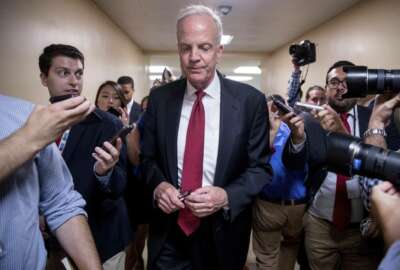
Rep. Hurd has a message to CFOs, others: Keep your hands off of IT modernization funds
Rep. Will Hurd (R-Texas) said the MGT Act protects against funds realized from IT modernization being taken for other uses in the agency.
With the Modernizing Government Technology (MGT) Act seemingly on a clear path to passage in the Defense authorization bill, the federal community is now asking two simple questions — how will the Trump administration implement the law? And what if chief financial officers and deputy secretaries don’t play nicely and use the money from the IT savings for other priorities?
While there is no simple answer to either of these questions, both Matt Lira, the special assistant to the president for innovation and policy initiatives, who works with the Office of American Innovation, and Rep. Will Hurd (R-Texas), the author of the MGT Act, are trying to lay the groundwork.
Let’s start with the second question first: What if CFOs or deputy secretaries don’t let agency chief information officers use all or some of the money realized by moving off of old systems to new ones?
Hurd said the MGT Act addresses that concern in the legislation.
“The legislation says that money can only be used for additional modernization. That’s why we needed that legislation to protect that money,” Hurd said, after speaking at the George Washington University Center for Cyber and Homeland Security event in Washington, D.C. on Sept. 29. “[The CFOs and deputy secretaries] would not have that ability unless they came back to Congress and Congress approved it.”
Hurd added that while there are 100 different scenarios for how the MGT Act may not work, the goal is to get it in place and address the challenges as they come up.
“Yes, it’s a concern, but that’s the point of the legislation and that’s why we spent so much time with appropriators, that’s why the appropriators have agreed to this and that’s why the appropriators’ insight into this legislation was so important,” he said.
And Hurd said he plans to add MGT Act implementation to the Federal IT Acquisition Reform Act (FITARA) scorecard.
“The FITARA scorecard is evolving to a digital hygiene scorecard. We will start keeping track of the working capital fund for modernization and whether you are taking advantage of it or not. If so, then there is a culture of modernization,” he said. “Some agencies will be able to take advantage of it and others will not. That is why having a working capital fund at each agency and a central fund made the most sense. We should have 26 different experiments on how to modernize federal IT infrastructure.”
Hurd said it’s clear that some CIOs will be more equipped than others to take advantage of the working capital fund.
“The Office of Management and Budget and OAI have been really intimately involved in the MGT Act process. They have ideas on how they want to implement it,” he said. “My biggest fear is CIOs are not prepared as soon as this goes into law to take advantage of it. That is where many folks can be helpful to some of these federal CIOs, to be put in a position to take advantage of MGT Act.”
That leads us down the effort by OAI and OMB to prepare for MGT.
The administration collected 93 comments on its draft IT modernization plan.
“It will be an interagency process to review the comments, and after the final update is cleared, it goes to the president for his review and approval,” Lira said in an interview after speaking at the Fedstival event, sponsored by Government Executive, in Washington on Sept. 19. “Anything that is short term will start to happen very quickly. The final report should speak to that in more detail as well.”
Lira said the biggest challenge is the sequencing of all the initiatives to ensure that they all lead to bigger and more impactful improvements over time, instead of just one-off wins.
Lira said every agency CIO faces different challenges to modernizing their technology, but the one common theme that comes out in meetings is for OMB and OAI to remove policy blockers that are out of date.
“These kinds of things have a real detrimental impact on the ability to use modern systems if they have out-of-date regulations governing their systems,” he said. “I know Margie Graves, the acting federal CIO, and many others are really proactively thinking about how to be air support for IT modernization and drive that along.”
OMB got rid of the first 59 of those outdated IT regulations in June.
The final strategy also will address one item that raised eyebrows in the draft report. In the initial version, OAI described a cloud email and collaboration pilot by calling out four vendors as “suggested industry partners” — Google, Salesforce, Amazon and Microsoft.
Lira said he doesn’t “anticipate” the final version will call out specific vendors to take part in pilots.
Another potential change that could come in the final IT strategy is more of a focus on improving citizen services.
The draft strategy included no mention of citizen services.
But Lira said at the TechTrends conference, sponsored by the Professional Services Council, that OAI’s top priority was improving citizen services.
“The actual experiences with government are wildly inconsistent with their expectations from even mid-level private-sector companies,” he said. “Everyone says it has to be as good as the top-level apps, and that would be great, but they aren’t even as good as mid-level apps. That drives public frustration and introduces inefficiencies, and are insecure.”
Lira said OAI will continue to bring stakeholders together to make IT modernization happen. He said the office is trying to create relationships between CIOs, CFOs and others, and address specific issues.
“We hope to set some sort of strategic visions collectively with all of those people as well,” he said. “One of the great assets of the last few years, both from the U.S. Digital Service, 18F and from an industry perspective, there has been a lot of efforts by a lot of actors to do some modernization, and some have succeeded and some have failed, and some are in progress. But what they all have done, regardless of what category they fall into, they have learned what the barriers are very intimately, whether it’s a legislative barrier, a culture barrier or a communication barrier. There is a lot of detail that may not have existed before, so we can get all these people together and figure out what is statutory and what is not. We’ve spent a lot of time together figuring out what is statutory, what is OMB guidance and what is agency interpretation. I think this will be an ongoing project to get us there.”
Return to the Reporter’s Notebook
Copyright © 2025 Federal News Network. All rights reserved. This website is not intended for users located within the European Economic Area.
Jason Miller is executive editor of Federal News Network and directs news coverage on the people, policy and programs of the federal government.
Follow @jmillerWFED





